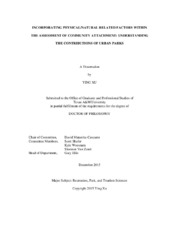| dc.contributor.advisor | Matarrita-Cascante, David | |
| dc.creator | Xu, Ying | |
| dc.date.accessioned | 2016-04-06T16:53:57Z | |
| dc.date.available | 2017-12-01T06:36:17Z | |
| dc.date.created | 2015-12 | |
| dc.date.issued | 2015-12-07 | |
| dc.date.submitted | December 2015 | |
| dc.identifier.uri | https://hdl.handle.net/1969.1/156306 | |
| dc.description.abstract | Community attachment describes individuals’ emotional investment in their community through feelings of rootedness and belonging. Community sociologists have predominantly examined community attachment by focusing almost exclusively on social relations. Recently, however, sociologists have noted their neglect of the physical place in traditional community sociological studies. They have thus started to bring the physical/natural environment into their discussions of community attachment. Nevertheless, at this point we are limited in our state of knowledge of the processes behind the physical/natural environment’s contribution to peoples’ attachment to their communities and whether the effect of such environment varies in different contexts
(urban vs. rural).
In an effort to expand our knowledge of this topic, this research aims primarily to explore the contributions of urban physical/natural landscape to community attachment. By selecting parks as a typical form of physical/natural landscape in cities, this study seeks to investigate how people’s levels of community attachment may be predicted by 1) peoples’ interactions with an urban park, 2) people’s emotional connections with such a park, 3) peoples’ social interactions with others within the park, and 4) perceived tourists’ influence on locals’ experience in the park.
This study’s data was collected in Discovery Green in Houston, Texas, between June 30 and July 18 of 2015. A total of 606 complete surveys were collected, with a response rate of 71.7 percent. After conducting a series of block model regression analyses, we found the strongest (and positive) predictor of community attachment was place identity. This indicates that the emotional and affective components of people-place relationship are relevant to understanding the local social fabric of a community. The study also found that residents’ perceptions of tourism influence on their emotional connections to the park were significantly and positively associated with community attachment. Respondents perceived tourists’ visits to the urban park as strengthening the symbolic meanings and emotional bonds they attributed to the park. Such strong emotional connections found expression in the increased community attachment to the park landscape.
This study, we believe, makes great contributions to the community literature exploring the role of physical/natural landscape in forming community attachment. It first shifts the discussion to the urban landscape in urban communities. Second, utilizing the measures derived from the sense-of-place construct, the study results empirically support the feasibility of synthesizing community and place theories to better understand relationships between people and locales. Third, the study findings are also informed by the urban park and tourism literature. While most of the relevant studies still remain on the descriptive level by counting the number of tourists and investigating their preferences and satisfactions in urban parks, our study has contributed to understanding how residents perceive tourism influence on their experience in urban parks. Finally, the recognition of the tourism-park-community relationships in this study provides significant practical implications for urban park planners and designers and tourism planners to promote their planning and management practices. | en |
| dc.format.mimetype | application/pdf | |
| dc.language.iso | en | |
| dc.subject | Community Attachment | en |
| dc.subject | Urban Parks | en |
| dc.title | Incorporating Physical/Natural Related Factors within the Assessment of Community Attachment: Understanding the Contributions of Urban Parks | en |
| dc.type | Thesis | en |
| thesis.degree.department | Recreation, Park, and Tourism Sciences | en |
| thesis.degree.discipline | Recreation, Park, and Tourism Sciences | en |
| thesis.degree.grantor | Texas A & M University | en |
| thesis.degree.name | Doctor of Philosophy | en |
| thesis.degree.level | Doctoral | en |
| dc.contributor.committeeMember | Shafer, Scott | |
| dc.contributor.committeeMember | Woosnam, Kyle | |
| dc.contributor.committeeMember | Van Zandt , Shannon | |
| dc.type.material | text | en |
| dc.date.updated | 2016-04-06T16:53:57Z | |
| local.embargo.terms | 2017-12-01 | |
| local.etdauthor.orcid | 0000-0002-0399-0439 | |


